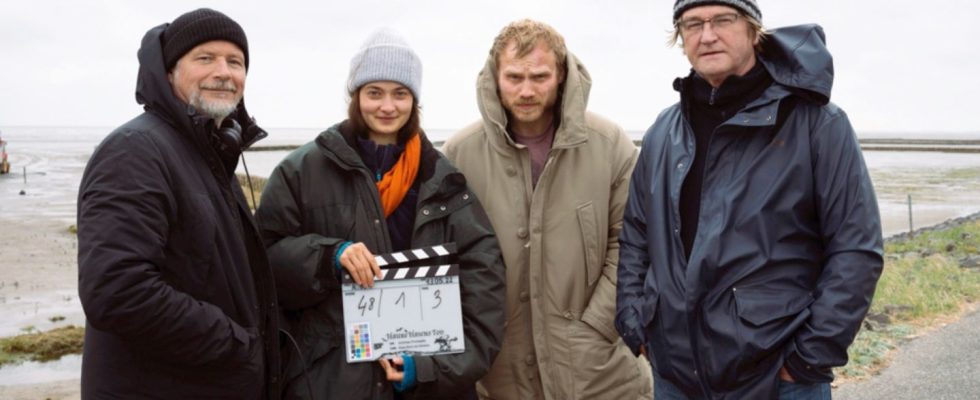TV review of “The Flood – Death on the Dike”
Slightly galloped: Habeck’s “Schimmelreiter” between mystery and nonsense
The ARD mystery drama “Hauke Haiens Tod” was directed by award-winning director Andreas Prochaska (“The Finstere Tal”). The main roles are played by Anton Spieker and Philine Schmölzer. From left to right: Andreas Prochaska (director), Philine Schmötzer (role Wienke), Anton Spieker (role Iven) and Detlev Buck (role Hauke Haien).
© ARD Photo
“Hauke Haien’s Death” is the title of a novel that Vice Chancellor Robert Habeck wrote with his wife at the beginning of the millennium. Now the material, very loosely based on Theodor Storm, is available as a primetime movie – visually strong, dramaturgically blown away.
“You have an aggression problem,” says Wienke Haien (Philine Schmölzer) at one point in the film to her reluctant partner, the strenuous Iven (Anton Spieker), who was just a bouncer in the neighborhood and has now driven to Stegebüll with her to solve the great family mystery of the Haiens. In fact, that’s one of the problems with this film – the incessant fidgeting, shouting and screaming of Hauke Haien’s “foster son”, but one after the other.
For almost ten years, from 2000 to 2009, the current Vice Chancellor and Federal Minister for Economic Affairs and Climate worked as a “freelance writer,” as his CV shows. During this time, he and his wife Andrea Paluch published a number of novels, including “Under the Gully Lies the Sea”, “The Day I Met My Dead Husband” and “Hauke Haien’s Death”.
Film based on Robert Habeck book: Iconic dike drama reflected in current weather extremes
The latter is a kind of sequel to Theodor Storm’s “Schimmelreiter”, as a North German mystery fairy tale between historical adaptation and the current climate crisis, the iconic dike drama reflected in current weather extremes. Sounds ambitious, and it is. Not least because the story also tries to pack a postmodern continuation of its protagonists into the saddlebags of the old gray horse as he rides past.
The focus of the story is the daughter of the dike chief Hauke Haien (Detlev Buck), 18-year-old Wienke, who suffers from an autism spectrum disorder. She was the only one from the Haien clan to survive the devastating North Sea storm surge that destroyed her home village of Stegebüll. While her parents died, Haien’s foster son Iven saved her from the floods.
A lot of things in “The Flood – Death on the Dike” remain piecemeal
Years later, Wienke and Iven meet again by chance in Hamburg. The girl really wants to find out what really happened back then. At first Iven is reluctant to help her, then a hefty sum is on the horizon and he agrees. Back in Stegebüll she meets the former mayor Ole Peters (Sascha Geršak), who doesn’t like the fact that people are digging into the past. And then there is Ole’s daughter Ann-Grethe (Janina Stopper), Iven’s former childhood crush.
So there’s a lot going on in this ambitious story, and who knows – if Iven didn’t constantly act above tolerable volume, especially in the first half of the film, you might be able to find your way into this somewhat convoluted plot with a little good will. But as it is, a lot of it remains piecemeal and the individual levels hardly fit together into a convincing whole. Sometimes there is charming, even questionable, autistic wink à la “Rain Man”, then it becomes mystery-mysterious, with dark hints and rainy flashbacks.
“The Flood – Death on the Dike”: You’re about to reach for your rubber boots
Visually, the whole thing works wonderfully, especially in the wide shots; cameraman Felix Novo de Oliveira knows what he’s doing. Looking at his pictures, you’re about to grab your rubber boots to book your next mudflat hike. Director Andreas Prochaska (“Traces of Evil: Guilt”) and his ensemble make a real effort, especially the Austrian Philine Schmölzer, who holds the common thread in her hands with nuanced acting.
Nevertheless, “The Flood – Death on the Dike”, which, based on its catchy title, belongs to the old “Sat1-Film-Film” school, turns out to be a moving image counterpart to the traffic light coalition: lots of good ideas, some indecisions, some chronically too loud, others stoic and quietly. Very late on, the whole thing finds a kind of rhythm, almost reminiscent of “Absolute Giganten” and the wish that there always had to be music somehow. Maybe that would have been the solution – if the Tocotronic record had simply been put on an hour earlier.


